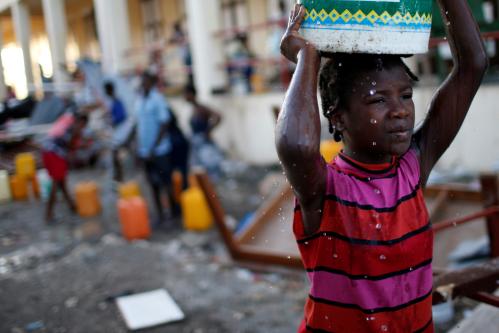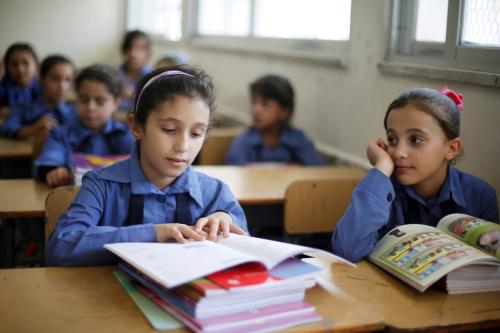This blog is the first in a four-part series related to a new paper on girls’ education and climate change, including an overview of the research, reproductive rights, fostering climate participation and leadership, and life skills for a green economy.
Recent incidents of severe weather and flooding in Bangladesh, Sierra Leone, the United States, and the Caribbean are once again heightening anxiety about climate change. What is the human impact on climate change, and what are the most effective policies and programs for mitigating this impact? In our new paper, Three Platforms for Girls’ Education in Climate Strategies, we show evidence that educating girls is one of the most effective but overlooked ways to mitigate against climate change, and present three platforms on which actors can be a part of this pursuit.
Climate change exacerbates existing gender inequalities by affecting the most vulnerable and least skilled people, largely women and girls, most acutely. For example, girls are at greater risk of early marriage in times of weather-related crises, because their dowries can help ease the burden of scarce household resources. Girls are often also the first to be withdrawn from school or attend school less frequently during times of drought so that they can complete household responsibilities like fetching water.
Despite this, we are beginning to acknowledge the powerful role that investments in girls’ education can play in climate change adaptation and mitigation. Our study suggests that for every additional year of schooling a girl receives on average, her country’s resilience to climate disasters can be expected to improve by 3.2 points (as measured by the ND-GAIN Index, which calculates a country’s vulnerability to climate change in relation to its resilience).
 Achieving gender equality and the Sustainable Development Goals requires multi-sectoral action, however, climate change strategies pursued by gender, education, and climate actors have remained largely confined to the sectors from which they stem. To address this gap, we lay out three specific platforms on which actors in these sectors can collaborate and support girls as agents of change in the pursuit of sustainable development and equitable climate action.
Achieving gender equality and the Sustainable Development Goals requires multi-sectoral action, however, climate change strategies pursued by gender, education, and climate actors have remained largely confined to the sectors from which they stem. To address this gap, we lay out three specific platforms on which actors in these sectors can collaborate and support girls as agents of change in the pursuit of sustainable development and equitable climate action.
1. Promote girls’ reproductive rights
There is a clear link between higher levels of female education and lower rates of fertility. But, efforts focused solely on reducing fertility rates and stabilizing population growth are wrought with ethical issues. Instead, the global community must approach women’s reproductive health from a gender justice and rights-based perspective delivered through quality girls’ education programming.
Key to this convergence are efforts to connect actors like CARE and Plan International—organizations that focus on the rights and empowerment of women and girls through education and health—with population-health-environment (PHE) actors working on women’s reproductive health as a means to achieve population-based climate change mitigation strategies. In addition, climate financing mechanisms like the Adaptation Fund should include investments in girls’ and women’s reproductive rights and education as part of their policy mechanisms for building women’s climate resilience and adaptive capacity. Accountability mechanisms like the OECD Development Assistance Committee (DAC) should also include it as part of their classification markers to track overseas development assistance going toward climate and gender action.
2. Invest in girls’ education to foster climate participation and leadership
Studies show that female leaders are incredibly effective in conservation and protection efforts, and are more likely to pursue more sustainable futures for their communities. However, as of 2015, women made up only 24 percent of the 173 focal points (or, delegates) to the U.N. Forum on Forests; 12 percent of the heads of 881 national environmental sector ministries; and 4 percent of 92 national member committee chairs to the World Energy Council.
Efforts to increase adult women’s participation and leadership miss a critical systemic approach that centers early learning and building a leadership pipeline of girls. Our forthcoming research in girls’ life skills education makes clear that developing skills like leadership as early as possible is key to the ambition of girls’ and women’s empowerment. Actors like the Campaign for Female Education’s CAMA Network or Rise Up’s network of youth champions must be brought into the space to ensure that girls have clear pathways to grow from youth leaders in their communities into adult leaders in, for example, key climate-financing institutions.
3. Develop girls’ life skills for a green economy
The transition to green economies has become a catch-all climate adaptation solution attracting multilaterals, corporations, governments, and civil society alike due to its promise of reconciling the paradoxes of development and environmental degradation. However, current workforce development efforts to retrofit women’s skills for green sector jobs come too late in a woman’s life, especially in regions with low levels of female education.
Instead, actors such as the European Centre for the Development of Vocational Training (Cedefop), the International Labour Organization (ILO), and the OECD—which are focused on building and monitoring green skills for inclusive growth—must extend green-sector training opportunities and green skills development specifically to girls and female youth through tailored girls’ education programming. Moreover, girls’ education actors focused on girls’ life skills development and on getting girls into science, technology, engineering, and mathematics (STEM) fields, like Code to Inspire in Afghanistan and the United Nations Girls’ Education Initiative’s UN Ivy STEM Connect Program, must begin to connect their agenda to green-sector career pathways.
Pursuing these three platforms means initiating discussions about the role of girls’ education in climate strategies with new global actors, including President of France Emmanuel Macron who has made a public commitment to support climate research and action. It also means bringing to the table actors from sectors typically disconnected to each other, including gender actors focused on women’s participation in climate action; education actors focused on youth skills development, climate change education, and girls in STEM; and climate actors focused on technical solutions like the development of clean energy technologies.
While there are still gaps in the evidence that need to be filled and questions that need to be explored, it is clear that achieving gender equality and women’s empowerment is key to tackling climate change. Investing in girls’ quality education is the foundation that must be achieved first. The world cannot wait.





Commentary
3 ways to link girls’ education actors to climate action
September 27, 2017